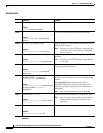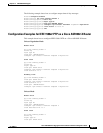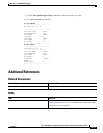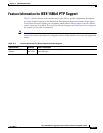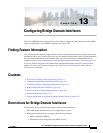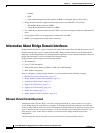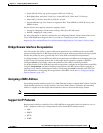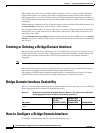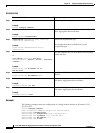
13-2
Cisco ASR 1000 Series Aggregation Services Routers Software Configuration Guide
OL-16506-17
Chapter 13 Configuring Bridge Domain Interfaces
Information About Bridge Domain Interfaces
–
Netflow
–
QOS
–
Network-Based Application Recognition (NBAR) or Advanced Video Coding (AVC)
• Bridge domain interfaces support the following features from IOS XE 3.8.2 and later:
–
Hot Standby Router Protocol (HSRP)
–
Virtual Router Redundancy Protocol (VRRP)
• For a BDI, the maximum transmission unit (MTU) size can be configured between 1500 and 9216
bytes.
• Cryptographic VPNs are not supported in combination with BDI.
• MPLS is not supported on bridge domain interfaces.
Information About Bridge Domain Interfaces
Bridge domain interface is a logical interface that allows bidirectional flow of traffic between a Layer 2
bridged network and a Layer 3 routed network traffic. Bridge domain interfaces are identified by the
same index as the bridge domain. Each bridge domain represents a Layer 2 broadcast domain. Only one
bridge domain interface can be associated with a bridge domain.
Bridge domain interface supports the following features:
• IP termination
• Layer 3 VPN termination
• Address Resolution Protocol (ARP), G-ARP, and P-ARP handling
• MAC address assignment
Prior to configuring a bridge domain interface, you must understand the following concepts:
• Ethernet Virtual Circuit Overview, page 13-2
• Bridge Domain Interface Encapsulation, page 13-3
• Assigning a MAC Address, page 13-3
• Support for IP Protocols, page 13-3
• Support for IP Forwarding, page 13-4
• Packet Forwarding, page 13-4
• Bridge Domain Interface Statistics, page 13-5
Ethernet Virtual Circuit Overview
An Ethernet Virtual Circuit (EVC) is an end-to-end representation of a single instance of a Layer 2
service being offered by a provider to a customer. It embodies the different parameters on which the
service is being offered. In the Cisco EVC Framework, the bridge domains are made up of one or more
Layer 2 interfaces known as service instances. A service instance is the instantiation of an EVC on a
given port on a given router. Service instance is associated with a bridge domain based on the
configuration.
An incoming frame can be classified as service instance based on the following criteria:



